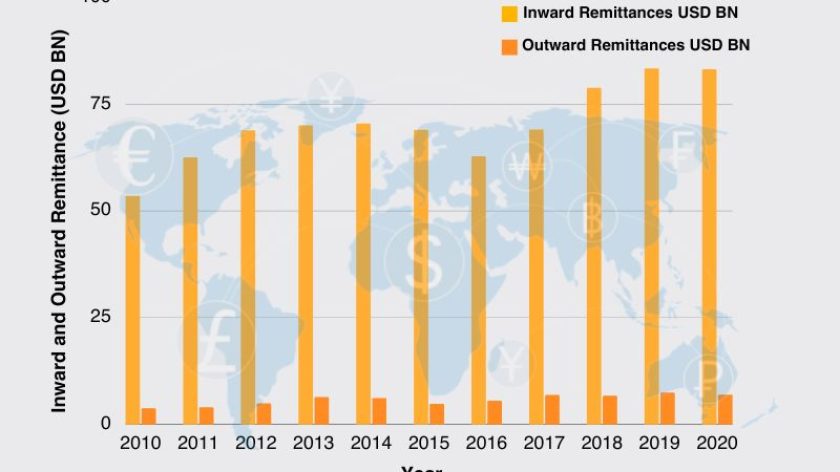An Assessment of Remittances to India: Facts and Impact

This blog post has been authored by Manish Vaidya, Economics Researcher at Arthashastra Intelligence
A recent report published by the World Bank postulates that India is on the path to account for more than USD 100 billion in yearly remittances, in 2022. Increasing immigration and brain drain to advanced economies are a few reasons for this. These contributions are by both, low-skilled labor and high-skilled labor. One of the other significant reasons as put by the bank is that migrants have moved from “low-skilled, informal employment” in the middle east and GCC nations, to high-skilled jobs in the US, UK, and East Asia.
Rising incomes abroad, Brain drain or globalization: What are the causal links for remittances to India?
It can be seen that remittances to India, have an upward trend. This further correlates with economic growth, migration of labor to developed economies, and rising incomes abroad. Over the years, rising immigration increased trade openness, and essentially the world just becoming more globalized are a few factors that have played a key role in shaping remittances to India. Increased emigration, or rather migration of talent to developed economies, has been a prime focus in recent years, and hence the term “Brain-drain”, or the human capital flight. Taking an introspection, there are a few concrete factors behind this. Unemployment, Immigration rules, Colonial links, Financial incentives and material benefits, Pursuit of higher education, Improved working conditions and facilities, Avoidance of excessive bureaucratic procedures, and Compensation for the mismatch between education and actual work. It can be said some of the very structural cords of the Indian economy and society, provide motivating grounds for able individuals to immigrate in pursuit of a better quality of life, income, and other socioeconomic conditions. Brain-Drain has its own costs and benefits in the form of remittances and loss of skilled labor, being the prime effects. However, it must also be noted that human capital is flowing out of economies where maximum contribution can be made to improve human welfare. This is not just with India-USA/UK/GCC/West migration but also seen in other parts of the world like Latin America to North America. Again, this is a welfare argument, the labor market is well driven by market forces, and to prevent emigration on the grounds of increasing domestic welfare is a bit stretched.
The Heckscher-Ohlin trade theory suggests that a country exports the good that it can easily produce, and has an abundance of inputs available in relative terms to produce that good. India has an abundance of human capital or skilled labor, thanks to the competitive educational environment and higher utility being attached to procuring skills and education. The US faces a skilled labor shortage and hence imports skilled labor from other nations and hence “Brain-Gains”. Henceforth, human capital flight is a justified phenomenon, at least in the realms of most contemporary trade theories, maybe until the welfare analysis is undertaken.
Source: World Bank; Compilation and Visualization By Arthashastra Intelligence.
As of 2022, the US, UAE, UK, and Singapore account for up to 54% of remittances to India. Higher education and attractive human capital credentials are amongst the key factors revitalizing Indian emigrants in procuring and professing high-paying jobs abroad. Fiscal stimulus in the West, increased oil prices, and the weakening of the rupee can be a few other factors that can be attributed to the reasoning behind record-high remittances to India
Human capital flight and domestic economic growth
Migrant remittances play a vital role in contributing to economic growth. Numerous studies have established this and found a strong causal link not just for India, but also for neighboring countries. Economic growth induced due to remittances is further fueled when the education levels and financial sector development is comparatively higher.
One of the most visible and popular instances of a remittance-induced economic boom is that of Kerala. The oil boom of 1973 in the Arabian Gulf, led to the development of a new labor market, in India. Kerala was the prime location for labor supply to the middle east. On average 22% of the state, income is solely from Gulf remittances. This emigration exodus also resulted in various socioeconomic paradigm shifts within the state. Economic prosperity, development, reduction of poverty, and increased acquisition of assets have been the key benefits. On the other hand, state inflation has also risen due to demand pressures, which disproportionately affects non-emigrant households in Kerala.
Henceforth, Emigration has its own set of negative and positive prospects. The focus must lie along the lines of making the best use of these remittances by channeling them into the formal economy, improving the domestic labor market and socioeconomic conditions to further increase domestic welfare, and progress the departure of India’s economy on par with its competitors.
References:
- Retrieved from The Indian Express (Author: Explained Desk) Why remittance to India is set to cross record $100-billion mark in 2022
- Retrieved from Money Control (Author: Sreedev Krishnakumar) Just 4 countries account for 54% of remittances to India, which will hit a record this year, shows data
- Siddique, A., Selvanathan, E.A. and Selvanathan, S., 2012. Remittances and economic growth: empirical evidence from Bangladesh, India, and Sri Lanka. Journal of development studies, 48(8), pp.1045-1062.
- Azam, Muhammad. “The role of migrant workers remittances in fostering economic growth: The four Asian developing countries’ experiences.” International Journal of Social Economics (2015).
- Oommen TK. India: ‘brain drain’ or the migration of talent? Int Migr. 1989 Sep;27(3):411-25. DOI: 10.1111/j.1468-2435.1989.tb00355.x. PMID: 12282407.
- Iravani, M.R., 2011. Brain drain problem: A review. International Journal of Business and Social Science, 2(15).
- Cooray, A., 2012. The impact of migrant remittances on economic growth: evidence from South Asia. Review of International Economics, 20(5), pp.985-998.
- Azeez, A. and Begum, M., 2009. Gulf migration, remittances, and economic impact. Journal of Social Sciences, 20(1), pp.55-60.
